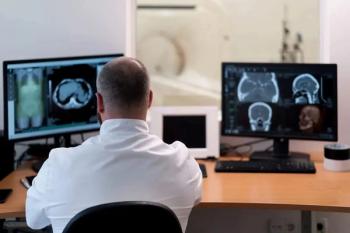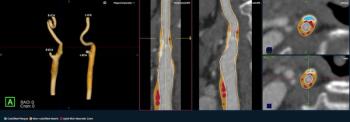
Gamma camera vendors chasesolid-state future at SNM show
GE and Digirad lay digital foundationVisitors to last month's Society of Nuclear Medicine meeting neededsharp eyes to see what could be one of the biggest developmentsin gamma camera instrumentation since the introduction of SPECT.It was easy to
GE and Digirad lay digital foundation
Visitors to last month's Society of Nuclear Medicine meeting neededsharp eyes to see what could be one of the biggest developmentsin gamma camera instrumentation since the introduction of SPECT.It was easy to miss the small booth on the SNM exhibit floor whereDigirad of San Diego made its commercial debut, or the modestdisplay in GE's booth that provided a rare peek at the Milwaukeecompany's product pipeline.
But for those in the know, the efforts of Digirad and GE to developsolid-state digital detectors represent an opportunity to creategamma cameras that are radically different from those on the market.If the technology proves itself, solid-state digital could sparkrenewed purchasing interest and lead to expanded applicationsfor nuclear medicine that could help pull the modality out ofits sales slump.
Digirad and GE are developing solid-state detectors independently,but the firms share some commonalities in their approaches. Bothare using cadmium zinc telluride as a material to develop detectorsthat are remarkably lightweight and portable.
GE announced earlier this year that it had formed a partnershipwith several other companies and had won a grant from the U.S.-IsraelScience and Technology Commission for its work on the detectors(SCAN 2/15/95). GE is collaborating with the eV Products divisionof II-VI Inc. and Israeli firm Soreq on the project.
Until the grant was announced, GE had remained above the marketingfray surrounding digital detectors that employ scintillation crystalsand photomultiplier tubes. GE felt that the value of Anger-styledigital technology had yet to be proven, according to James Shepard,general manager of GE's global nuclear and PET business.
"This was another case where in the industry as a wholethere was a little more hype than actual activity," Shepardsaid. I don't remember too many folks saying they got better images."They just said they had digital detectors."
Swords to plowshares. Digirad is taking a different path to asimilar destination. Some years ago the company developed a cost-effectiveway of growing solid-state crystals by using a technique knownas a modified high-pressure Bridgeman method. The method allowsthe growth of large cadmium telluride crystals, to which Digiradhas added zinc to improve its energy resolution characteristics,according to Richard Conwell, vice president of business developmentat Digirad.
The firm initially used its crystal-growing technology to developa solid-state gamma camera to detect radiation emitted from thenose cones of Soviet missiles for defense treaty verification(SCAN 5/10/95). The end of the Cold War eliminated the need forsuch a device, but Digirad began to pursue nuclear medicine applicationsfor the camera on the advice of Dr. William Ashburn, formerlychief of nuclear medicine at the University of California at SanDiego.
At the Minneapolis meeting, Digirad displayed a solid-state detectorhead measuring 8 x 8 inches and weighing about 25 pounds withcollimator. Digirad has not yet collected data on the detector'stechnical specifications.
Digirad is developing a mobile gamma camera targeted at organ-specificapplications such as cardiac or breast imaging, with the potentialfor intraoperative uses. Its system will be mounted on a cartsimilar to an ultrasound scanner and will weigh less than 400pounds, making it easily maneuverable.
The cost of manufacturing solid-state detectors has been an issueclouding the potential acceptance of the technology, but Conwellbelieves that the price of Digirad's systems will be competitive.The small-field-of-view camera the company is developing willcost less than $250,000. Digirad could also make large FOV camerasbut has decided to target the mobile niche first, due to the opportunityin that segment.
"There is nothing that limits our fabricating larger detectorheads," Conwell said. "There seemed to be an opportunityfor a small field-of-view, truly portable camera."
Digirad has not yet decided whether to build a direct salesforce to market the system or to pair up with a larger vendor.Regardless of its ultimate path to market, the company hopes tohave a prototype on display at this year's Radiological Societyof North America meeting, with a 510(k) application on file withthe Food and Drug Administration by the middle of 1996.
"It's been very encouraging to hear the number of peoplewho see this camera as having great potential to return to thearea of organ-specific imaging," Conwell said.
Newsletter
Stay at the forefront of radiology with the Diagnostic Imaging newsletter, delivering the latest news, clinical insights, and imaging advancements for today’s radiologists.






























